Слайд 2REVISITING THE MARKET EQUILIBRIUM
Do the equilibrium price and quantity maximize the total

welfare of buyers and sellers?
Market equilibrium reflects the way markets allocate scarce resources.
Whether the market allocation is desirable can be addressed by welfare economics.
Слайд 3Welfare Economics
Welfare economics is the study of how the allocation of resources
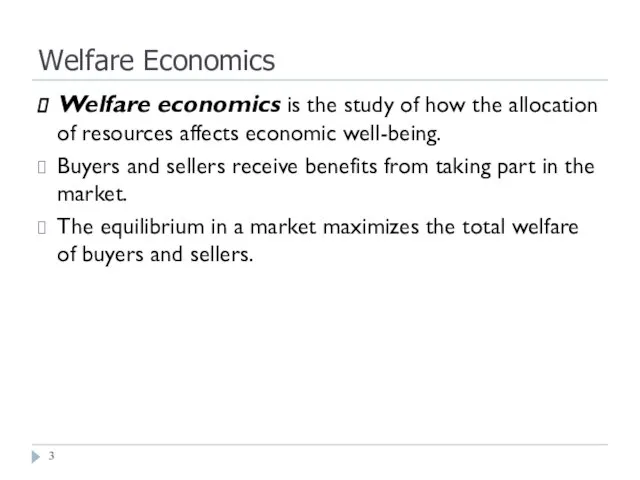
affects economic well-being.
Buyers and sellers receive benefits from taking part in the market.
The equilibrium in a market maximizes the total welfare of buyers and sellers.
Слайд 4Welfare Economics
Equilibrium in the market results in maximum benefits, and therefore maximum

total welfare for both the consumers and the producers of the product.
Слайд 5Welfare Economics
Consumer surplus measures economic welfare from the buyer’s side.
Producer surplus measures

economic welfare from the seller’s side.
Слайд 6CONSUMER SURPLUS
Willingness to pay is the maximum amount that a buyer will
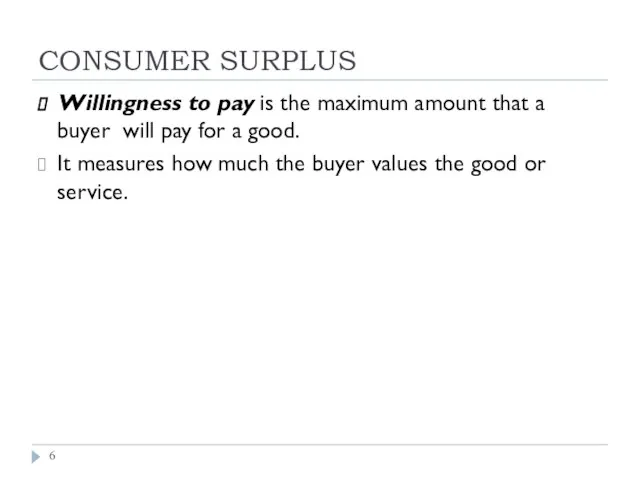
pay for a good.
It measures how much the buyer values the good or service.
Слайд 7CONSUMER SURPLUS
Consumer surplus is the buyer’s willingness to pay for a good
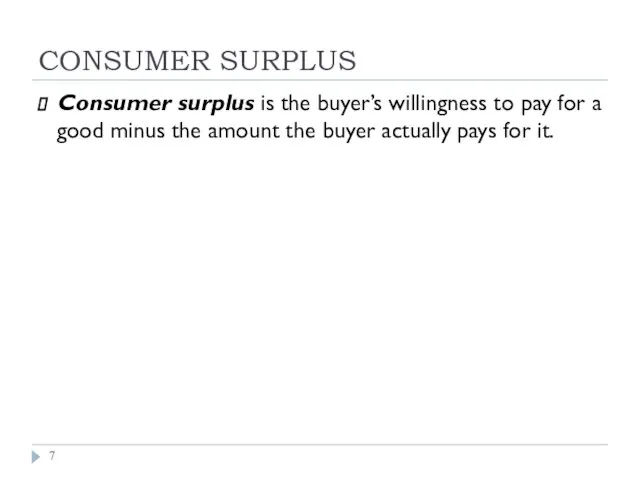
minus the amount the buyer actually pays for it.
Слайд 8CONSUMER SURPLUS
The market demand curve depicts the various quantities that buyers would
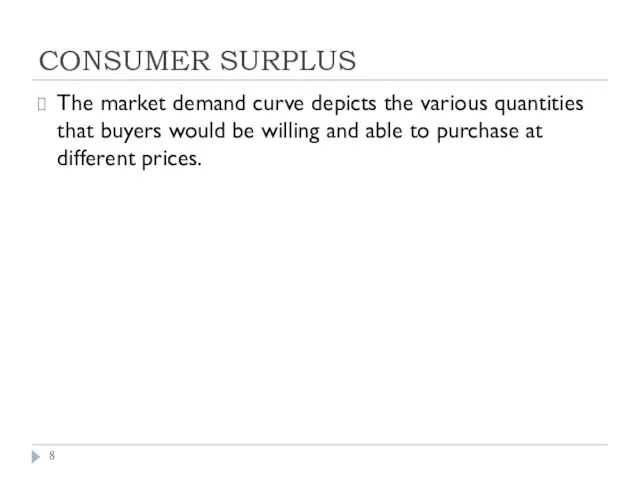
be willing and able to purchase at different prices.
Слайд 9Using the Demand Curve to Measure Consumer Surplus
The area below the demand
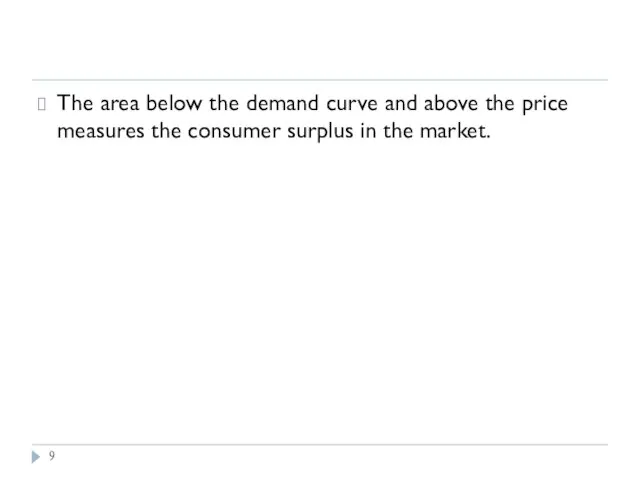
curve and above the price measures the consumer surplus in the market.
Слайд 10How the Price Affects Consumer Surplus
Quantity
(a) Consumer Surplus at Price
P
Price
0
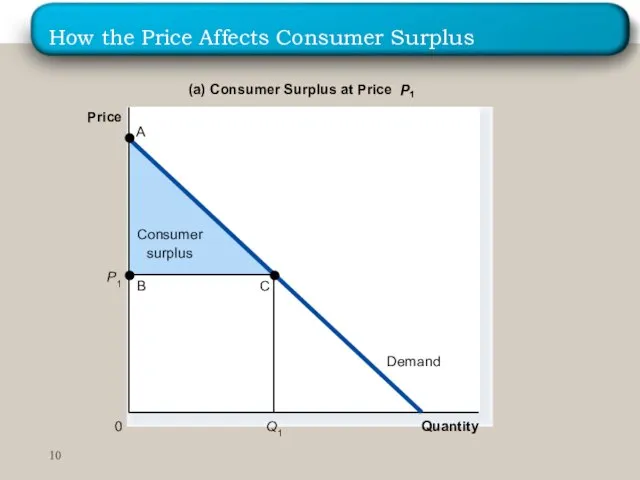
Слайд 11What Does Consumer Surplus Measure?
Consumer surplus, the amount that buyers are willing

to pay for a good minus the amount they actually pay for it, measures the benefit that buyers receive from a good as the buyers themselves perceive it.
Слайд 12PRODUCER SURPLUS
Producer surplus is the amount a seller is paid for a

good minus the seller’s cost.
It measures the benefit to sellers participating in a market.
Слайд 13Using the Supply Curve to Measure Producer Surplus
Just as consumer surplus is
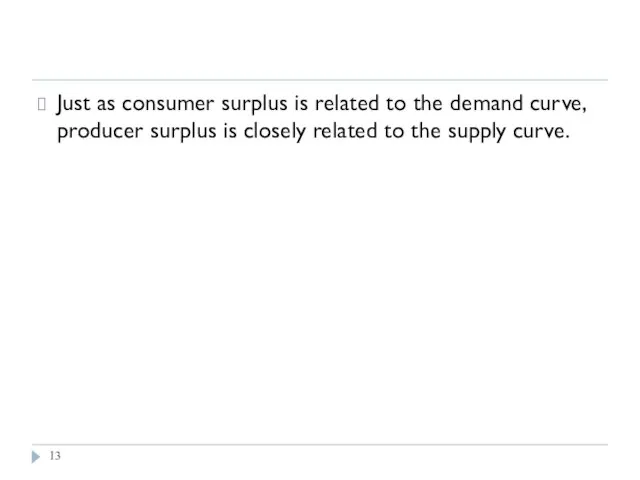
related to the demand curve, producer surplus is closely related to the supply curve.
Слайд 14How the Price Affects Producer Surplus
Quantity
(a) Producer Surplus at Price
P
Price
0
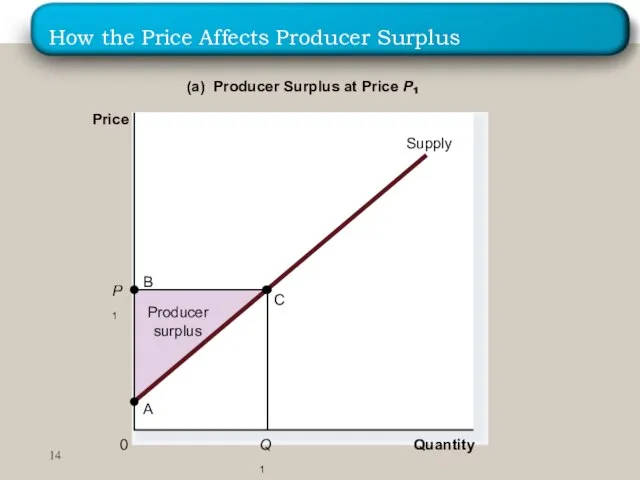
Слайд 15MARKET EFFICIENCY
Consumer surplus and producer surplus may be used to address the
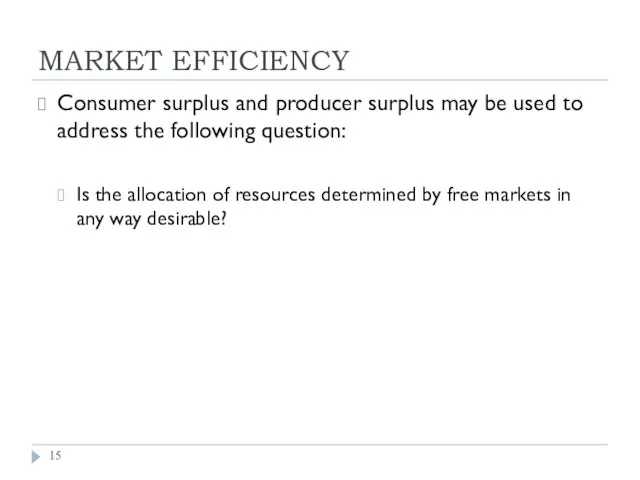
following question:
Is the allocation of resources determined by free markets in any way desirable?
Слайд 16MARKET EFFICIENCY
Consumer Surplus
= Value to buyers – Amount paid by buyers
and
Producer

Surplus
= Amount received by sellers – Cost to sellers
Слайд 17MARKET EFFICIENCY
Total surplus
= Consumer surplus + Producer surplus
or
Total surplus
= Value
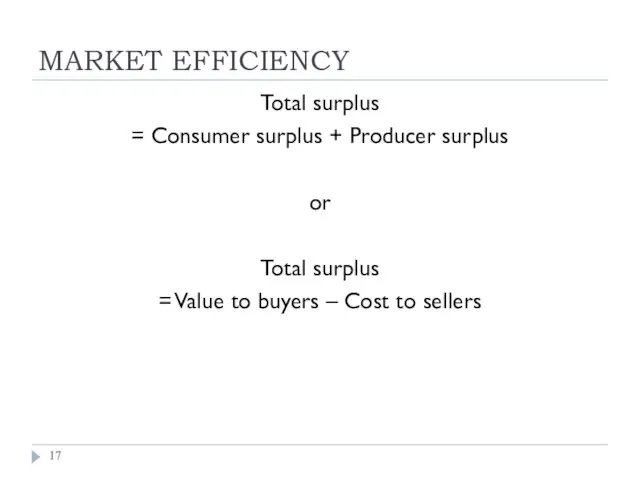
to buyers – Cost to sellers
Слайд 18MARKET EFFICIENCY
Efficiency is the property of a resource allocation of maximizing the
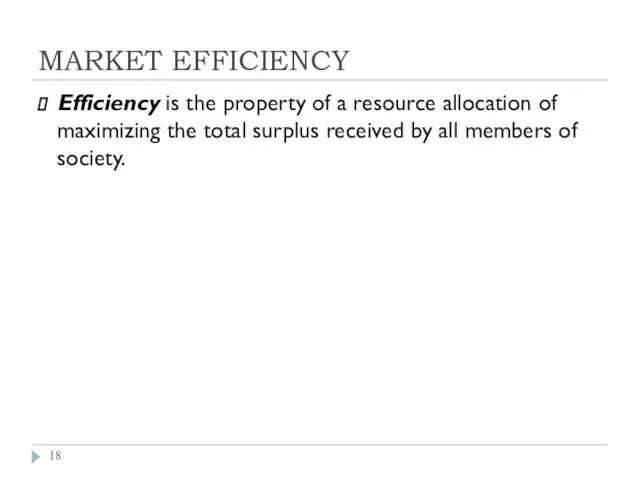
total surplus received by all members of society.
Слайд 19MARKET EFFICIENCY
In addition to market efficiency, a social planner might also care
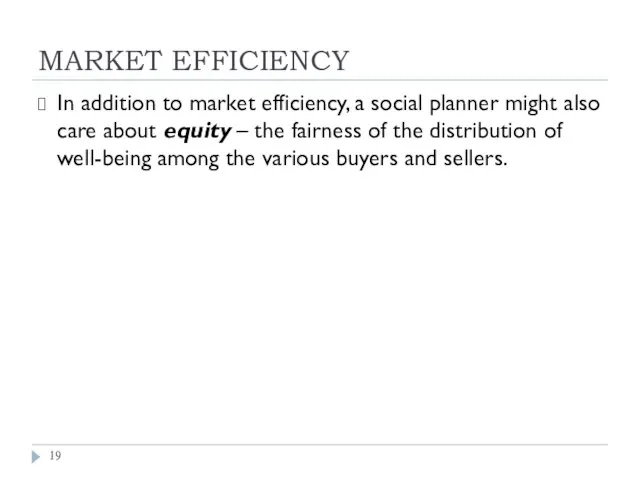
about equity – the fairness of the distribution of well-being among the various buyers and sellers.
Слайд 20 Consumer and Producer Surplus in the Market Equilibrium
Price
0
Quantity
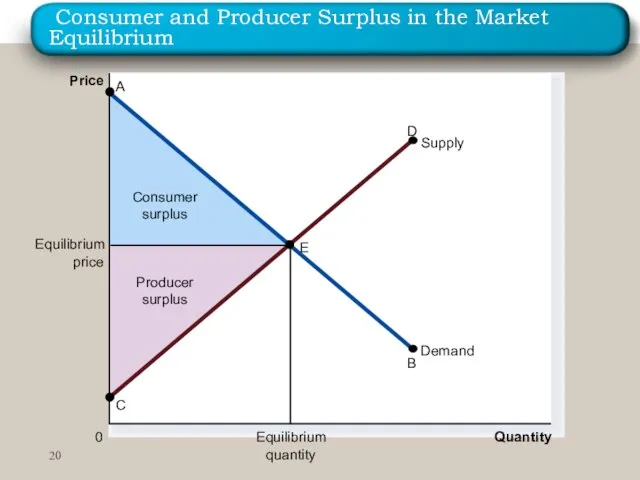
Слайд 21MARKET EFFICIENCY
Three Insights Concerning Market Outcomes
Free markets allocate the supply of
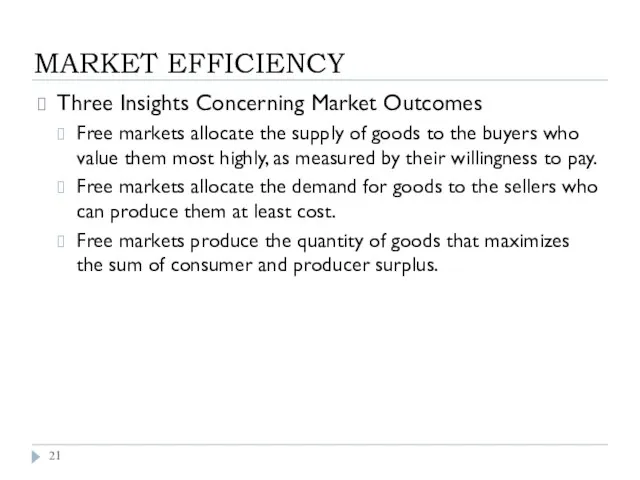
goods to the buyers who value them most highly, as measured by their willingness to pay.
Free markets allocate the demand for goods to the sellers who can produce them at least cost.
Free markets produce the quantity of goods that maximizes the sum of consumer and producer surplus.
Слайд 22The Efficiency of the Equilibrium Quantity
Quantity
Price
0
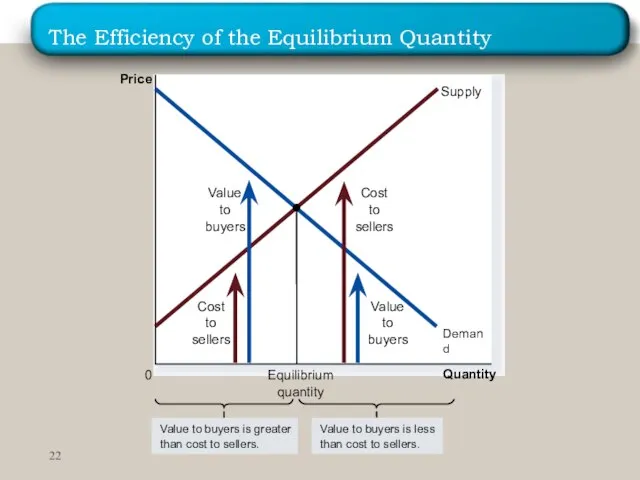
Слайд 23Evaluating the Market Equilibrium
Because the equilibrium outcome is an efficient allocation of
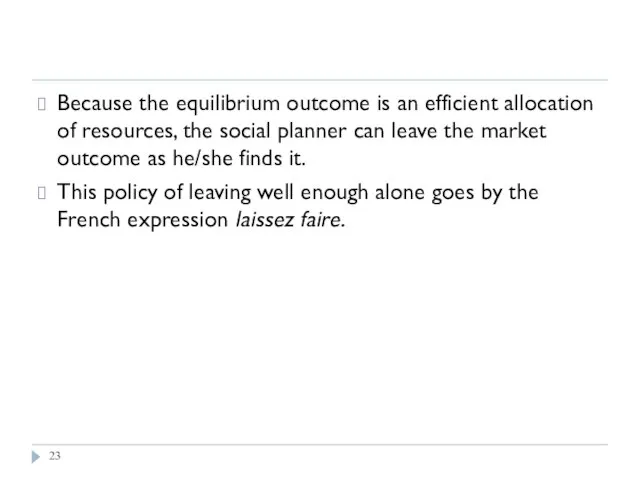
resources, the social planner can leave the market outcome as he/she finds it.
This policy of leaving well enough alone goes by the French expression laissez faire.
Слайд 24Evaluating the Market Equilibrium
Market Power
If a market system is not perfectly
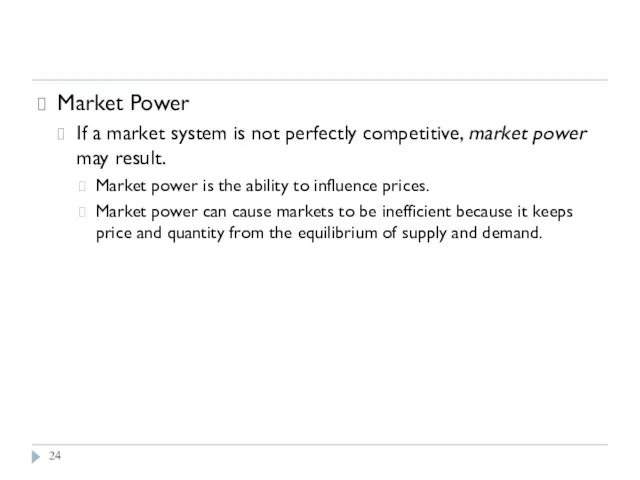
competitive, market power may result.
Market power is the ability to influence prices.
Market power can cause markets to be inefficient because it keeps price and quantity from the equilibrium of supply and demand.
Слайд 25Evaluating the Market Equilibrium
Externalities
created when a market outcome affects individuals other
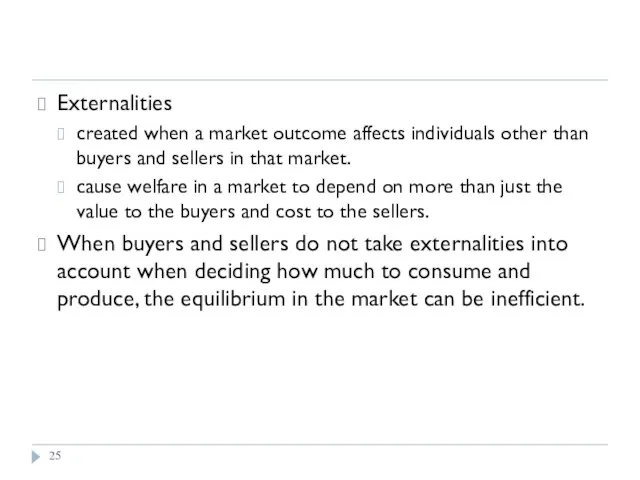
than buyers and sellers in that market.
cause welfare in a market to depend on more than just the value to the buyers and cost to the sellers.
When buyers and sellers do not take externalities into account when deciding how much to consume and produce, the equilibrium in the market can be inefficient.
Слайд 26Summary
Consumer surplus equals buyers’ willingness to pay for a good minus the

amount they actually pay for it.
Consumer surplus measures the benefit buyers get from participating in a market.
Consumer surplus can be computed by finding the area below the demand curve and above the price.
Слайд 27Summary
Producer surplus equals the amount sellers receive for their goods minus their
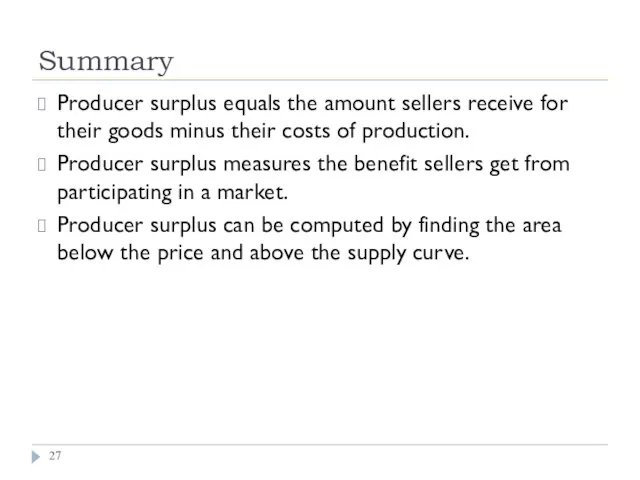
costs of production.
Producer surplus measures the benefit sellers get from participating in a market.
Producer surplus can be computed by finding the area below the price and above the supply curve.
Слайд 28Summary
An allocation of resources that maximizes the sum of consumer and producer
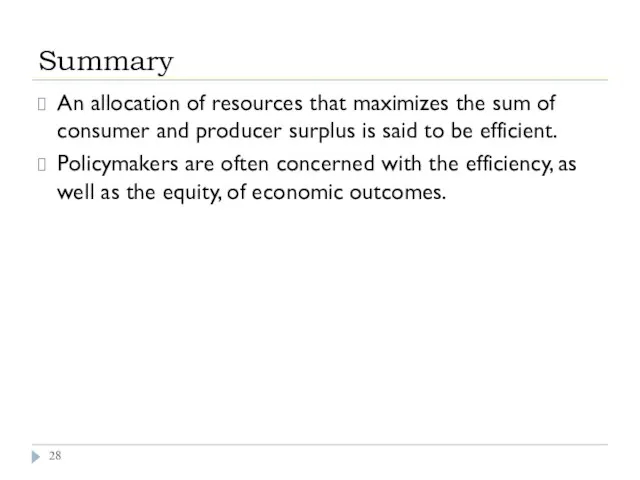
surplus is said to be efficient.
Policymakers are often concerned with the efficiency, as well as the equity, of economic outcomes.



























 Презентация на тему Варны и касты в Древней Индии
Презентация на тему Варны и касты в Древней Индии  Ремонт электроплиты
Ремонт электроплиты Современное антикоррозионное покрытие
Современное антикоррозионное покрытие Фото+Лого. Добавление к заказу
Фото+Лого. Добавление к заказу Финансовые проекты Восточного направления
Финансовые проекты Восточного направления Причины ухудшения коэффициента мощности. Пути улучшения коэффициента мощности
Причины ухудшения коэффициента мощности. Пути улучшения коэффициента мощности Секция учителей географии
Секция учителей географии Архитектура Древнего Рима
Архитектура Древнего Рима Теоретико-методологические подходы в современной науке
Теоретико-методологические подходы в современной науке Яңы йыл байрамы
Яңы йыл байрамы Презентация на тему Море
Презентация на тему Море Московский Кремль
Московский Кремль Конституционный Суд Российской Федерации, конституционные (уставные) суды субъектов Российской Федерации. Верховный Суд РФ
Конституционный Суд Российской Федерации, конституционные (уставные) суды субъектов Российской Федерации. Верховный Суд РФ Умный дом
Умный дом 543814
543814 Презентация на тему Изготовление витражной картины
Презентация на тему Изготовление витражной картины Фотосессия с символом 2019 года
Фотосессия с символом 2019 года Дружок
Дружок Projekt
Projekt Всемирное антидопинговое агентство (World Anti-Doping Agency, WADA)
Всемирное антидопинговое агентство (World Anti-Doping Agency, WADA) Місто Катовіце в Польщі. Програма два дипломи
Місто Катовіце в Польщі. Програма два дипломи Невская битва
Невская битва Искусство презентации
Искусство презентации Проект развития и поддержки
Проект развития и поддержки ПРОГНОЗИРОВАНИЕ КУРСОВ ВАЛЮТ С ИСПОЛЬЗОВАНИЕМ НЕЙРОСЕТЕВЫХ ТЕХНОЛОГИЙ
ПРОГНОЗИРОВАНИЕ КУРСОВ ВАЛЮТ С ИСПОЛЬЗОВАНИЕМ НЕЙРОСЕТЕВЫХ ТЕХНОЛОГИЙ Как риелтору быть вне конкуренции?
Как риелтору быть вне конкуренции? Презентация на тему Классификация неорганических веществ
Презентация на тему Классификация неорганических веществ Презентация на тему Словарные слова
Презентация на тему Словарные слова